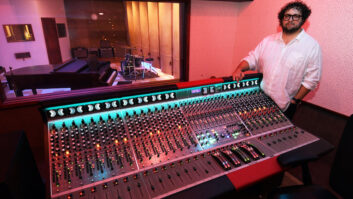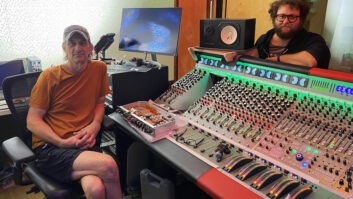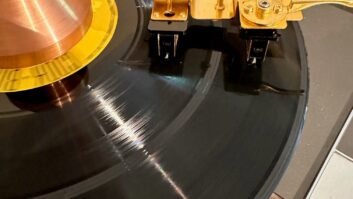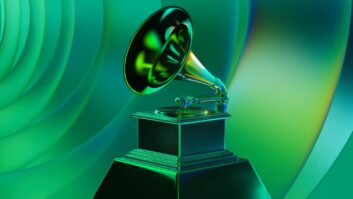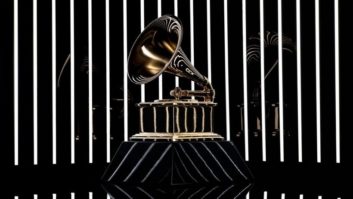Essex, UK (February 1, 2019)—Rustin Man, otherwise known as Paul Webb, Talk Talk’s founding bass player, is a man out of time. That’s not to suggest that his number is up, but rather that his new album, Drift Code, 16 years in the making, inspired by music of the 1940s and with intentional tempo fluctuations, stands apart from much of today’s beat-mapped, pitch-corrected fare.
Drift Code, released today on Domino, is the second album to bear the Rustin Man name. The first, Out of Season, released in 2002, was a collaboration with Portishead’s Beth Gibbons. Webb has been busy in the years since, raising a family in a converted barn in the county of Essex, northeast of London, and learning engineering. “With Talk Talk, I didn’t really pick much [engineering] up; I was just concerned about bass playing,” he says.
During the 1990s, Webb and Lee Harris, Talk Talk’s drummer, had a band project, .O.rang, that recorded a couple of albums with a variety of guests. But while Harris was getting to grips with digital audio technology, says Webb, “I was learning more about performance at that time.”
Then he collaborated with Gibbons. “She had a Trident desk and she knew her way around a compressor,” he says. After .O.rang, the return to analog was inspiring. “I thought, I’ve really missed this. By the time I’d finished, I wanted to learn engineering and recording, the old-school side. That’s when I started buying microphones and preamps and experimenting with them, learning on the job.”
As Drift Code started to come together, he says, “The first thing I did was write the songs, the melodies and the structures, and the core arrangements. Then I sat down to record the songs on an acoustic guitar, just the fundamental arrangements.”
Inspiration for the album came from 1940s music by the likes of the Mills Brothers and Cab Calloway. “It was a very innocent age, lyrically—even though it probably wasn’t innocent at all. Also, coming off tour with Beth and having played a lot of loud guitar, I imagined what it would have sounded like if you went into a session with a guitar and a lot of effects in the 1940s and joined in.”
The tempo of any given song could vary according to Webb’s vocal delivery. “I wanted that in the performance,” he says. He then applied a MIDI template, locking in any tempo variations. “That was when I got Lee involved and we put the drums to those MIDI files.”

The barn is both recording studio and home. “I made these huge mic cables so that we could record anywhere. But to live in a house that’s like a recording studio would have been too much, so we put statues and ornaments all around and disguised it. That created an otherworldly atmosphere,” he says.
Indeed, atmosphere and environment are central to Webb’s creativity. “Making records is a lot of decision making. When you’re not sure, just play and walk around the house; it’s almost like playing into the atmosphere. When we put the drums down, we went into every room in the barn to hear what the sound was like and ended up in the roof, where one of my daughters sleeps. It has a good ‘triangular’ sound; we did most of the drums there.”
Webb’s recording setup is simple—essentially, Pro Tools and six channels of mics and preamps, plus an SSL X-Desk. “I bought a collection of microphones, like the Soundelux ELUX 251 and the 47C. Those were the drum sounds,” he says. “An old Neve 1073 was my main preamp. The other preamps were a Chandler TG2 and a Great River.”
Webb, a multi-instrumentalist, began building the arrangements. “I’d already got into the habit of recording six microphones, so each instrument I added, I used six mics. I tried various mics in different locations, and I made a library of those recordings.”
He would also record multiple takes, he says, to give himself additional options later in the process. “There might be a bass fill later on that I might need room for, so I would record a few versions, one with the acoustic guitar playing through, one where I played less.” Alternatively, if a guitar part intruded on the bass, he says, he could select a room mic track instead.
Webb brought in local musicians to add violin and cello, and a teacher at the school where one of his daughters attends added trumpet, flugelhorn and euphonium. Webb’s schoolfriend, Mark Cotgrove, better known as Latin percussionist Snowboy, brought his Clavioline to the barn and contributed some keyboard parts.
About halfway through the project, Webb says, “I took on a few production jobs with a few bands,” including UK singer-songwriter James Yorkston, Belgian duo Dez Mona and Swedish band The Tiny. “They were all acts who had their own personalities and knew what they wanted to do, so I could go in and explore production ideas with them. It was worth doing. It gave me more confidence when I came back to my own stuff to carry on what I was doing.”
Webb’s learn-as-you-go engineering process further benefitted from his friendship with Phill Brown. The legendary recording engineer, whose credits include sessions with Jimi Hendrix, the Rolling Stones and Led Zeppelin, and who worked on two Talk Talk albums, offered Webb some pointers. “He taught me things like, don’t add top to stuff. And don’t add EQ, just take it away, for a more natural sound.”
Once Webb finished tracking, he invited Brown to take a listen: “He said it felt like it was 85 percent mixed.”
Webb set about completing the album, aided by his latest discovery, Universal Audio plug-ins. “They really helped me with mixing. The equalizers and the compressors sounded very real to me. I kept it very simple. I stayed on the Neve 1081 EQ, and I put the Studer A800 on everything; I like the tape saturation you can get from that.”
He laughs, “And you could use 15 Fairchilds if you wanted, which was a complete luxury. Someone told me you shouldn’t use a valve compressor with a valve mic, but back in the 1940s, that’s all they had, and that sounded alright to me.”
Webb is now exploring the possibility of playing some live shows. “It’s weird being a 57-year-old and becoming a singer for the first time; it’s quite daunting. But we’ll see if we can get a few gigs sorted out.”
Rustin Man • www.rustinman.com


